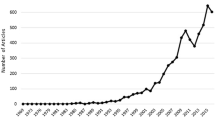Abstract
The research area of scientometrics began during the second half of the nineteenth century. After decades of growth, the international field of scientometrics has become increasingly mature. This study intends to understand the evolution of the collaboration network in the field of scientometrics. The growth of the discipline is divided into three stages: the first period (1987–1996), the second period (1997–2006), and the third period (2007–2015). Macro-level, meso-level, and micro-level network measures across the time periods are compared. Macro-level analyses show that the degree distribution of the collaboration in each time span are consistent with power-law, and that both the average degree and average distance steadily increase with time. From the meso-level perspective, the increase of the number of clusters in the collaboration networks suggests the emergence of more collaborative fields in scientometrics. Moreover, the growth of the size of primary clusters demonstrates the expansion of the research fields and the collaboration range. Micro-level structure analyses identify the authors/researchers with high performance in raw degree measure, degree centrality measure, and betweenness measure, all of which are dynamic across different time spans. From three dimensions (raw degree, degree centrality, and betweenness centrality), the collaboration dominators are identified for each time span.





Similar content being viewed by others
References
Albert, R., & Barabási, A.-L. (2002). Statistical mechanics of complex networks. Reviews of Modern Physics, 74(1), 47–97. doi:10.1103/RevModPhys.74.47.
Ardanuy, J. (2012). Scientific collaboration in library and information science viewed through the web of knowledge: The Spanish case. Scientometrics, 90(3), 877–890.
Barabási, A. L., Jeong, H., Neda, Z., Ravasz, E., Schubert, A., & Vicsek, T. (2002). Evolution of the social network of scientific collaborations. Physica A: Statistical Mechanics and its Applications, 311(3–4), 590–614.
Borgatti, S. P., Everett, M. G., & Freeman, L. C. (2002). Ucinet 6 for windows: Software for social network analysis. Harvard, MA: Analytic Technologies.
Breiger, R. L. (1974). The duality of persons and groups. Social Forces, 53(2), 181–190.
Chen, Y., Börner, K., & Fang, S. (2013). Evolving collaboration networks in scientometrics in 1978–2010: A micro–macro analysis. Scientometrics, 95(3), 1051–1070.
Ding, Y., Rousseau, R., & Wolfram, D. (Eds.). (2014). Measuring scholarly impact: Methods and practice (2014th ed.). New York: Springer.
Franceschet, M. (2011). Collaboration in computer science: A network science approach. Journal of the American Society for Information Science and Technology, 62(10), 1992–2012. doi:10.1002/asi.21614.
Freeman, L. C. (1978). Centrality in social networks conceptual clarification. Social Networks, 1(3), 215–239.
Glänzel, W., & Schubert, A. (2004). Analysing scientific networks through co-authorship. In H. F. Moed, W. Glänzel & U. Schmoch (Eds.), Handbook of quantitative science and technology research (pp. 257–276). Springer: Netherlands.
Hou, H. (2006). Study on the evolution of scientometrics based on the scientific map. Retrieved from http://www.cnki.net/.
Hou, H., Kretschmer, H., & Liu, Z. (2008). The structure of scientific collaboration networks in scientometrics. Scientometics, 75(2), 189–202.
Koopman, R., Wang, S., Scharnhorst, A., & Englebienne, G. (2015). Ariadne’s thread-interactive navigation in a world of networked information. doi:10.1145/2702613.2732781.
Milojević, S., & Leydesdorff, L. (2013). Information metrics (iMetrics): A research specialty with a socio-cognitive identity? Scientometrics, 95(1), 141–157. doi:10.1007/s11192-012-0861-z.
Nalimov, V. V., & Mulchenko, B. M. (1969). Scientometrics. Moscow: Nauka. (in Russian).
Newman, M. (2001). Scientific collaboration networks. Network construction and fundamental results. Physical Review E, 64(1), 016131.
Otte, E., & Rousseau, R. (2002). Social network analysis: A powerful strategy, also for the information sciences. Journal of Information Science, 28(6), 441–453. doi:10.1177/016555150202800601.
Pang, J. (2002). The research methodology of scientometrics. Beijing, China: Scientific and Technical Documentation Press.
Schoepflin, U., & Glänzel, W. (2001). Little scientometrics, big scientometrics…and beyond? Scientometrics, 30, 376.
Schubert, A. (2002). The web of scientometrics: A statistical overview of the first 50 volumes of the journal. Scientometics, 53(1), 3–20.
Watts, D. J., & Strogatz, S. H. (1998). Collective dynamics of “small-world” networks. Nature, 393(6684), 440–442.
Yin, L., Kretschmer, H., Hanneman, R. A., & Liu, Z. (2006). Connection and stratification in research collaboration: An analysis of the COLLNET network. Information Processing and Management, 42(6), 1599–1613.
Yuan, J. (2010). The advanced tutorial of scientometrics. Beijing, China: Scientific and Technical Documentation Press.
Author information
Authors and Affiliations
Corresponding author
Rights and permissions
About this article
Cite this article
Zhao, Y., Zhao, R. An evolutionary analysis of collaboration networks in scientometrics. Scientometrics 107, 759–772 (2016). https://doi.org/10.1007/s11192-016-1857-x
Received:
Published:
Issue Date:
DOI: https://doi.org/10.1007/s11192-016-1857-x




